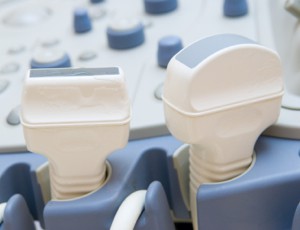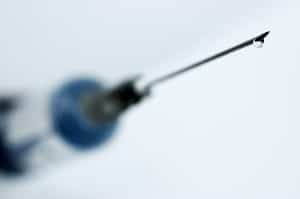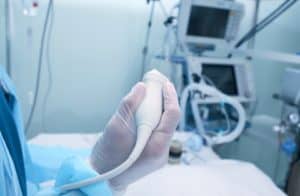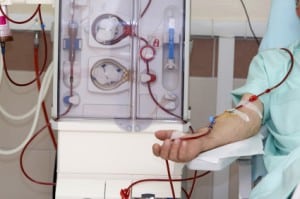Faculty opinions concerning ultrasound utilization in the emergency department

As point-of-care ultrasound (POCUS) is becoming increasingly pervasive in the emergency department (ED), ultrasound is being incorporated into medical education targeting every stage of training: medical school, residency, and fellowship [1-4]” Graglia et al (2018). Abstract: As point-of-care ultrasound (POCUS) is becoming increasingly pervasive in the emergency department (ED), ultrasound is being incorporated into medical […]
Quality improvement initiative reduces the occurrence of PICC complications

The vascular access team of 1 midwestern hospital used a quality improvement initiative to reduce the occurrence of complications associated with PICCs” Walters and Price (2019).
Article focusses on drugs that are hazardous to health care personnel

Antineoplastic and other hazardous drugs present a risk to health care personnel if they are not contained by appropriate facility design, personal protective equipment, and work practices that support safety” Kienle(2019). Abstract: Antineoplastic and other hazardous drugs present a risk to health care personnel if they are not contained by appropriate facility design, personal protective […]
Literature review of the pulsatile flushing technique

Recently, in vitro studies regarding pulsatile flushing have shed light on the usefulness of this technique” Boord (2019). Abstract: Flushing is an essential strategy in maintaining patency of a central vascular access device. However, there is no standard practice regarding flushing techniques. Pulsatile flushing has been discussed in the past based on the principles of […]
Trends in Infusion administrative practices in US health care

Owing to this trend, as well as recent government interventions in medical error control, the authors engaged in an exploratory study of infusion administration practices in the US health care industry” Pratt et al (2019). Abstract: While specialized infusion clinical services remain the standard of care, widespread curtailing and disbanding of infusion teams as a […]
Improving aseptic technique during the treatment of pediatric septic shock

Two methods of fluid resuscitation-the commonly used push-pull technique (PPT) and a new fluid infusion technique using the LifeFlow device (410 Medical, Inc; Durham, NC)-were compared in a simulated patient model” Spangler et al (2019). Abstract: Rapid fluid resuscitation is used to treat pediatric septic shock. However, achieving fluid delivery goals while maintaining aseptic technique […]
Serious complications of intraosseous access during infant resuscitation

We report on a 2.5-month-old infant with ischemia of the left leg and compartment following intraosseous needle application during resuscitation” Molacek et al (2018). Abstract: We report on a 2.5-month-old infant with ischemia of the left leg and compartment following intraosseous needle application during resuscitation. Unfortunately, this event led to major limb amputation. The cause, […]
Fluoroscopy-guided subclavian vein catheterization in children

Fluoroscopy-guided subclavian vein catheterization in children is a safe procedure, with a high success rate, resulting in a reduced number of venipunctures, optimal catheter placement, and reduced complications” Pang et al (2018). Abstract: Subclavian vein catheterization plays an important role in the treatment of children with hematologic disease. However, catheter placement is a difficult and […]
Robot-based distraction for venipuncture pain in children

We propose that interaction with a humanoid robot may effectively distract children during IVI thereby reducing their pain and distress” Ali et al (2018). Abstract: INTRODUCTION: Intravenous insertion (IVI) is a very common procedure in the emergency department (ED). IVI is often painful and stressful for both children and their families. Currently, distraction therapy is […]
Phlebotomists knowledge about the preanalytic phase of venipuncture

In order to reduce the preanalytical errors, we aimed to determine the level of phlebotomists knowledge about the preanalytic phase before and after planned trainings in the study” Arslan et al (2018). Abstract: BACKGROUND: The most common sources of error in the preanalytical phase are considered to be at the stage of patient preparation and […]
Effect of educational hypermedia on venipuncture knowledge

To assess the effectiveness of an educational hypermedia in the knowledge of Nursing academics on peripheral venipuncture” Frota et al (2018). Abstract: OBJECTIVE: To assess the effectiveness of an educational hypermedia in the knowledge of Nursing academics on peripheral venipuncture. METHOD: Quasi-experimental study with pre and post-test design. RESULTS: The mean number of right answers […]
Study reports perceptions and impact of accidental dislodgement with IV devices

This study reports perceptions and impact of accidental dislodgement with IV devices. Inconsistencies exist with use, application, and management of catheter securement and dressings for IV catheters” Moureau (2018). Abstract: Background: Dislodgement rates with intravenous catheters are reported at 1.8%-24% events per year resulting in failed access, interrupted treatment, and greater resource consumption with catheter […]
Mid-thigh femoral Peripherally Inserted Central Catheter placement

Health conditions such as diabetes, high cholesterol, chronic kidney disease, and obesity all impact patients’ vessel health and complicate intravenous access. Fundamental medical care relies on intravenous access in the hospital setting and is the route for medication administration, diagnostic treatments, and other therapies” Girgenti and Pieroni (2018). Abstract: In today’s healthcare environment patients require […]
Incidence of peripherally inserted central catheter–related deep venous thrombosis

To investigate the incidence of peripherally inserted central catheter–related deep venous thrombosis (PRDVT) and their associated risk factors of PRDVT in the oncological patients who received peripherally inserted central catheters” Jianning et al (2018). Abstract: Objective: To investigate the incidence of peripherally inserted central catheter–related deep venous thrombosis (PRDVT) and their associated risk factors of […]
Patency rate of Arteriovenous Fistula created for hemodialysis

Careful preoperative patient assessment, optimal surgical techniques, and adequate postoperative care play an important role for the favorable outcome. The primary patency rate in male hemodialysis patients was significantly higher than in female patients” Tjang and Sumadi (2018). Abstract: Introduction: Clinical practice guidelines endorse the arteriovenous fistula as the preferred form of vascular access. Concerns […]
Optimal hemodialysis catheter insertion can be done with no x-ray

The use of a dual vector positioning system in this study demonstrated optimal hemodialysis catheter insertion can be done with no X-ray and no increase in mechanical complications” Ramirez et al (2018). Abstract: Acute care hemodialysis catheters have traditionally been validated for use through chest X-ray interpretation. This study was implemented to evaluate if hemodialysis […]
Risk factors associated with adverse events in neonates with PICC

The aim of the study was to describe the occurrence of adverse events in newborns with peripherally inserted central catheters and to determine the risk factors associated with them” Padilla-Sánchez et al (2018). Abstract: BACKGROUND: Peripherally inserted central catheters have become a priority in infants who require long-term intravenous therapy, but their use involves certain […]
Effectiveness of chlorhexidine bathing for preventing HAI among adult intensive care patients

A systematic literature search was undertaken to identify trials assessing the effectiveness of chlorhexidine bathing to reduce risk of infection, among adult intensive care patients” Frost et al (2018). Abstract: BACKGROUND: Health care associated infections (HAI) among adults admitted to the intensive care unit (ICU) have been shown to increase length of stay, the cost […]
Nationwide surveillance study of catheter-related infections

To estimate the incidence and epidemiology of catheter-related bloodstream infections (CRBSIs) on a national scale by using prospective epidemiological data from the Swiss Antibiotic Resistance Surveillance System (ANRESIS)” Buetti et al (2018). Abstract: OBJECTIVES: To estimate the incidence and epidemiology of catheter-related bloodstream infections (CRBSIs) on a national scale by using prospective epidemiological data from […]
Principles of intravenous drug infusion in anaesthesia

The physicochemical properties of different drugs result in very different behaviours, especially following cessation of intravenous infusion” Chambers (2018). Abstract: Intravenous infusions are required when a drug has a short half-life or a narrow therapeutic window. Pharmacokinetic models are employed to calculate the infusion rate for a particular target plasma concentration. While the one-compartment model […]
Informed consent process for PICC patients

This paper describes a patient-centered, systematic, multidisciplinary approach to develop, implement, and alpha test a multimedia PtDA to reform the informed consent process of a PICC for patients in 10 acute and intensive care units” Sowan et al (2018). Abstract: BACKGROUND: Informed consent has considerable clinical, ethical, and legal implications for patient safety and liability. […]
Central venous catheter-related bacteraemia in HIV-infected versus non-HIV-infected patients

There is a paucity of data on the prevalence and pattern of pathogenic organisms in haemodialysed HIV-infected versus non-HIV-infected patients with end-stage kidney disease” Avila-Danguillecourt et al (2018). Abstract: BACKGROUND: Central venous catheter (CVC) haemodialysis (HD) to implement renal replacement therapy is the preferred choice in the urgent setting. Unfortunately, CVC placement is associated with […]
Povidone-iodine lowers incidence of catheter-associated bloodstream infections

Our data indicate that the incidence of infections caused by CV catheters was significantly reduced using povidone-iodine; therefore, we recommend this procedure for routine administration of chemotherapy” Sugiyama et al (2018). Abstract: BACKGROUND: Central venous (CV) catheters are required for the administration of chemotherapy. However, they may become a source of life-threatening infections of the […]
Bloodstream infection in hematopoietic stem cell transplantation outpatients

We described 235 bloodstream infection (BSI) episodes in 146 hematopoietic stem cell transplantation (HSCT) outpatients and evaluated risk factors for hospitalization and death. Records of outpatients presenting with positive blood cultures over a 5-year period (January 2005 to December 2008) were reviewed” Russo et al (2018). Abstract: We described 235 bloodstream infection (BSI) episodes in […]
Central catheter-related complications among Japanese patients

The aim of this study was to estimate the incidence of complications in Japanese patients with CVCs, including patients with SBS using CVCs” wing et al (2018). Abstract: PURPOSE: Short bowel syndrome (SBS) is a serious rare disorder that is usually managed with parenteral nutrition. Central venous catheter (CVC)-related complications are known to occur, but […]
ECG method for confirming central venous catheter tip placement

The objective of this study is to compare the accurate placement of the CVC tip using anatomical landmark technique with ECG-guided technique” Krishnan et al (2018). Abstract: BACKGROUND: The current standard followed for assessing central venous catheter (CVC) tip placement location is through radiological confirmation using chest X-ray (CXR). Placement of CVCs under electrocardiogram (ECG) […]
Early detection and prompt treatment of infiltration and extravasation

The potential complications of infiltration and extravasation are common in this population. Consequences of infiltration and extravasation may be prevented or mitigated by early detection and prompt treatment” Desarno et al (2018). Abstract: The vast majority of infants in the NICU receive peripheral intravenous (PIV) therapy for administration of fluids, nutrition, medications, and blood products. […]
Bilateral hydrothorax case as a rare outcome of central venous catheter placement

CVC placement is a relatively safe procedure but may occasionally be associated with complications, such as pneumothorax, haemothorax, cardiac tamponade, sepsis and thrombosis” Batihan et al (2018). Abstract: Central venous catheters (CVCs) are very useful tools in clinical medicine. It is important not only for the administration of medications or fluids but also the measurement […]
Point-of-care ultrasound evaluation and puncture simulation of the internal jugular vein

To show that medical students can evaluate the internal jugular vein (IJV) and its anatomical variations after rapid and focused training. We also aimed to evaluate the success rate of IJV puncture in simulation following traditional techniques (TTs) and monitored via ultrasound (US)” Pazeli et al (2018). Abstract: OBJECTIVES: To show that medical students can […]
Review of low-lying umbilical venous catheters

Conventional neonatology practice is to place umbilical venous catheters (UVCs) in central position and to limit the use of low-lying catheters. Our objectives were to describe the practices and complications associated with UVCs and to evaluate the type of infusates used with either UVC position” El Ters et al (2018). Abstract: OBJECTIVES: Conventional neonatology practice […]

